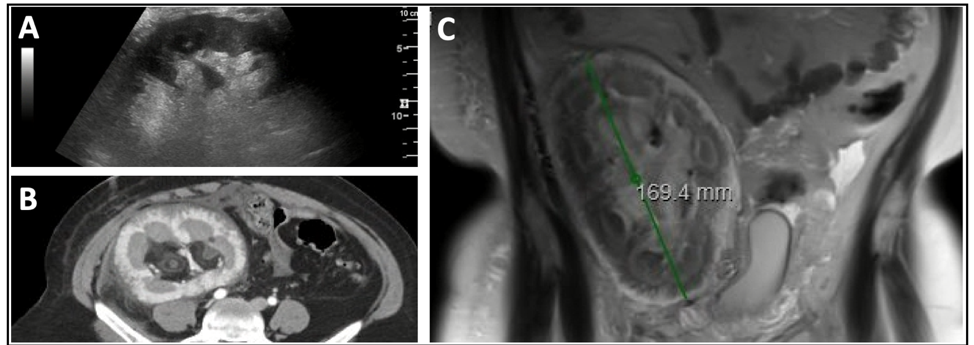Renal Allograft Lymphangiectasia: A Rare Post-Transplant Complication
1Medicine/Nephrology, Washington University in St. Louis, St. Louis, MO, 2Washington University School of Medicine in St. Louis, Saint Louis, MO
Meeting: 2022 American Transplant Congress
Abstract number: 1726
Keywords: Kidney transplantation
Topic: Clinical Science » Kidney » 46 - Kidney Complications: Non-Immune Mediated Late Graft Failure
Session Information
Session Name: Kidney Complications: Non-Immune Mediated Late Graft Failure
Session Type: Poster Abstract
Date: Tuesday, June 7, 2022
Session Time: 7:00pm-8:00pm
 Presentation Time: 7:00pm-8:00pm
Presentation Time: 7:00pm-8:00pm
Location: Hynes Halls C & D
*Purpose: Lymphangiectasia of the kidney is a rare condition characterized by benign intrarenal or extrarenal dilatation of lymphatics in the peripelvic and the perinephric regions. It is rare in native kidneys and rarer in transplants. To date, there are two reported cases of extrarenal and one intrarenal lymphangiectasia. We present a second case of intrarenal lymphangiectasia six years after transplantation.
*Methods: A 35-year old female with history of lupus nephritis underwent deceased donor kidney transplant in 2015. She presented with right lower quadrant abdominal pain and distension. Serum creatinine was stable at 0.99mg/dL. Urinalysis demonstrated urine protein:creatinine ratio of 6.1mg/gm compared to 161mg/gm a year prior. Allograft ultrasonography (US) demonstrated an enlarged kidney of 17cm with no obstruction or hydronephrosis. (Fig. 1A) Computed tomography (CT) scan with contrast confirmed enlargement, but inconclusive for etiology. (Fig. 1B) Patient underwent transplant biopsy to rule out infiltrative process e.g. lymphoma. Biopsy was consistent with chronic active antibody-mediated rejection which was treated per our institution’s protocol. To further investigate the enlargement cause, we conducted Magnetic resonance imaging (MRI) which demonstrated extensive edema throughout the renal sinus with edema in right lower quadrant soft tissues. (Fig. 1C) After detailed discussion with the radiologist, findings were consistent with impaired lymphatic drainage, establishing diagnosis of intrarenal lymphangiectasia.
*Results: Differential diagnoses for an enlarged allograft can include hematoma, abscess, infiltration or lymphatic dysfunction. In our case, renal enlargement was identified with US and CT but MRI was the critical modality that characterized fluid collection and its relationship to lymphatic system. Since renal function was stable, no intervention was done since potential risk of drainage outweighs benefit.
*Conclusions: This is a very rare benign post-transplant complication thought to be caused by impaired lymphatic drainage between renal and retroperitoneal lymphatics leading to dilatation of the lymphatic vessels and enlargement of the kidney. It can be carefully watched if asymptomatic and if there is no impairment in renal function. Symptomatic patients can be treated with aspiration and possibly surgical peritoneal fenestration. mTOR inhibitors may be beneficial for intrarenal lymphangiectasia, Nephrectomy is very rarely performed and mainly reserved for complicated collections.
To cite this abstract in AMA style:
Ibrahim MM, Santos RDelos, Java A. Renal Allograft Lymphangiectasia: A Rare Post-Transplant Complication [abstract]. Am J Transplant. 2022; 22 (suppl 3). https://atcmeetingabstracts.com/abstract/renal-allograft-lymphangiectasia-a-rare-post-transplant-complication/. Accessed December 18, 2025.« Back to 2022 American Transplant Congress

